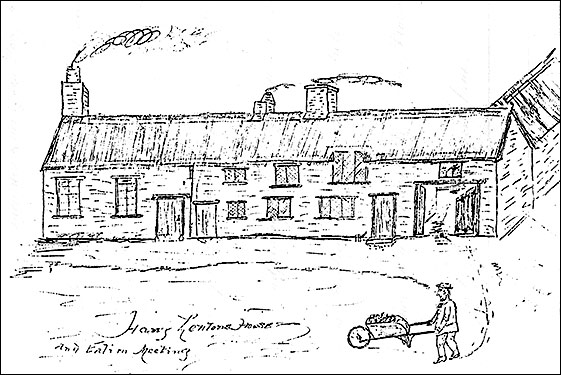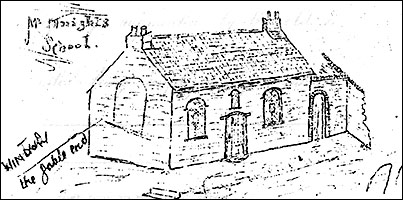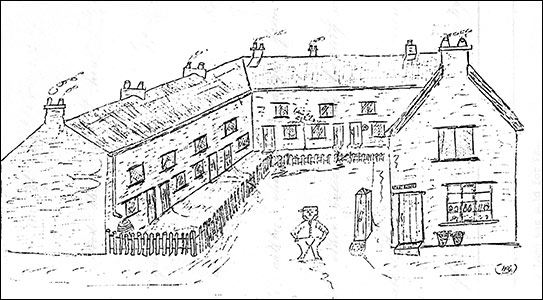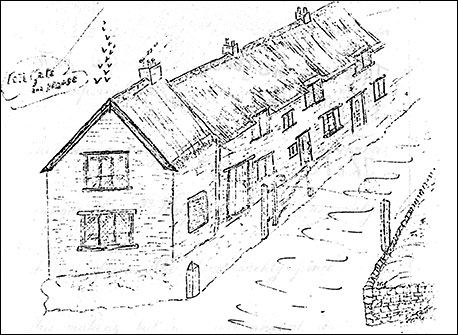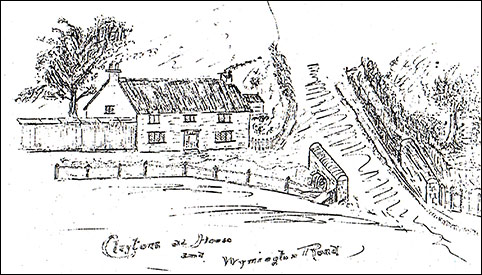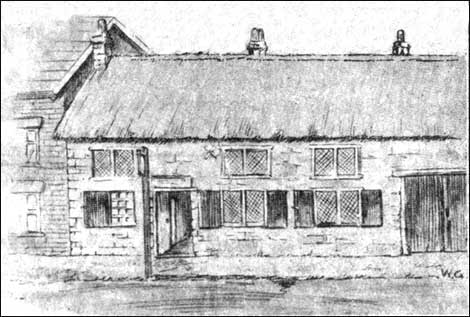|
|||||||||||||||||||
| Walter Green 1892 |
|||||||||||||||||||
|
Walter Green - Memories of the 1860s
|
|||||||||||||||||||
|
|
|||||||||||||||||||
|
This book of memories of the 1860s is enhanced with sketches showing some long gone places.
The sketches are the only record of these buildings, making this an important record. It is also enhanced with some illuminated lettering. |
|||||||||||||||||||
|
I have often thought and still love to think of Rushden my birthplace, and believing there to be no written account of what was in the 60s an insignificant and almost unheard of village, I have the presumption to here record a few of my earliest recollections of that place, and trust my humble efforts to interest will not be altogether in vain.
Rushden at that time was a long and straggling village of probably not more than a thousand inhabitants, and consisting of almost one street viz: High Street extending north and south. The houses excepting about fifteen or twenty were all low stone built with tiled or thatched roofs. Footpaths were latter day improvements, as also were street lamps. The public buildings consisted exclusively of the parish church and several chapels, and those in a very delapidated condition; it is needless to write lengthily of the first named, as it will doubtless stand centuries yet to tell of itself. The Old Baptist Meeting (commonly called) Top Meeting, probably the most important place of worship was situate in Little Street, closely adjoining the then rectory; well do I remember the dear old place with its antiquated square, high back pews and the little box like pulpit, which on Sunday was occupied by the Reverend Robert Emms Bradfield. The habitual worshippers there included men of whom it might be said "made Rushden". "Drawbridges meeting" properly called Succoth Baptist Chapel, was a commodious red brick building situate in the High Street opposite Higgins Lane. Next in importance was the Wesleyan Chapel at the end of Chapel Lane a very small place 'though moderately well attended. A penny savings bank was in existence here which was the first instituted thing of the kind in Rushden. Ealim Meeting completed the list of places of worship which was a stone built and thatched place standing in the High Street a little to the north of where a coffee tavern now stands. I believe this was also a Baptist Chapel.
Of school life in those days I could write much. The only public one at that time was kept by a Mr. Ebenezer Knight, and situate where now stands the Vestry Hall. I can now, as it were, see the venerable old schoolmaster a thin man of medium height, active, long nose, small keen eyes with spectacles and standing many hours of the day behind a rickety old desk, with the chastening rod in his hand, you may imagine the latter when I quote as under a well known and oft repeated ditty amongst us boys.
You must bear in mind that schools of this day were not under the supervielence of government, nor did they receive any grant or state allowances, consequently Mr. Knight's income was solely derived from the boys weekly pence and this making but a small amount was very frequently augmented by the old schoolmaster being employed by neighbouring farmers to measure land, manure etc. which of course consisted of square and cubic measurements which very few at that time were able to grasp. Often was it the master was sent for during the school hours, when pleasurable gleams passed over the boys faces as such meant instant dismissal, probably for the remainder of school hours that day. Another school though principally for girls was kept by one Richard Wagstaffe and his wife, and was principally supported by the church going people, this was a small thatched building adjoining the green. It would perhaps not be out of place to mention that of the time I write compulsory education was unknown and few of the children of poorer parents ever went to school. Books, either reading or copy writing, were very scarce and were only given to the older scholars, and when the last named books were filled the texts were usually cut off and used for copying on to the slates by the younger boys. A schoolmaster then was in a degree a professional caretaker many children doing nothing more than sit on the form all day. Before I write of the old Rushden houses I would like to acquaint you with the course of the brook, which found its way through the village, and in several places formed the roadway for vehicular traffic, and in wet seasons the water ran several feet deep. It entered the south end of the village running past Wyldes's farm and was crossed by a bridge at the southern extremity of Little Street, and pursuing its course three or four hundred yards on the east side of the High Street again crossed the road, and ran on the west side until it reached the old Tan Yard (opposite Crab Street), when it entered the Hall grounds imerging again at the foot of the green and once more crossed the road, when its bed formed nearly the whole length of Duck Street. Of the old houses numbering about 260 at the time, and which long ago succumbered to the demands of progress, the following perhaps would be the most interesting. The old Post Office yard was one of the early demolitions. It was a property situate about sixty yards to the south of the Coffee House but on the opposite side. There was in the yard ten houses in one of which lived my grandmother, a good Christian old woman of very even temper, devoid of all self aggrandisement, and ever ready to do any act of kindness that she was able. Born in 1800 died 1883.
Perhaps the most important property was from Chapel Lane along the High Street to the Church Lane. I have heard my father say that the whole property extending round the Back Lane was sold for £80. At the end of High Street and Church Lane stood the old Toll house and gate; these gates were placed on all roads and a charge was levied on all horses, carts, cattle, sheep, etc. ranging from 1½d to 6d, other gates in the locality were situate Higham Ferrers, Irthlingborough, Wellingborough, Westwood (Bedford Road) and Wymington.
Many were the stratagems to avoid payment which sometimes could be managed by taking circuitous routes. The tollman usually kept the gate closed, and took payment before letting traffic through. George Claridge, the father of the Rushden Claridges officiated in my early days. On or near where the Coffee Tavern now stands was Henry Lenten's house and premises, this old man died in the 60s and was succeeded by his son Harry, a half silly man; they sold coal, wood etc. and kept a worn out old horse to do the general carting of the village; almost adjoining the above house was Ealim meeting, next a small field, then two old cottages, then came Denton's shoe factory near Chapel Lane. Writing of shoe factories I might say something of manufacturing in these times. I think of the first men who commenced were Jickey Elstow and Benjamin Denton. What a revolution in the trade since those times, there was no machinery of any description, everything was done by hand, men working in many cases ninety eight hours per week, and he was a smart workman who in those times earned more than a pound, there was no particular hours for closing the factories (shops then called) half past ten in the week time, and twelve on Saturdays. I have known the railway drays from Irchester, the nearest station, waiting for goods up to ten o'clock. This was usual; I quote one reliable instance of the late hours then in vogue. There was a man working for Mr. John Cave named Clark, who on one Saturday night found his master's shop closed, but nothing daunted (people are not easily daunted when they want money) he proceeded to arouse his sleeping master who on opening his bedroom window ejaculated "It's past twelve Jim", "No" replied the latter, "it wants ten minutes". However Clark had the doubt and his money also if Cave sinned he did it unconsciously. Women principally, closed the uppers, of course by hand, using awl, wax thread, rarely silk and a pair of clamps, the latter were for tightly hold and [holding?] the work and which they stood between their knees. Women earned five or six shillings per week. Boys started work at seven or eight years of age, wages 6d per week and they [worked] 70 or 80 hours. It is not a little surprising the strides that Rushden as a village has made, considering its many drawbacks, for instance no railway facilities? Why! I remember the time when neither horse or pony trap could be hired, the only available conveyance procurable being a donkey and cart, and that only at times when the owner (a baker) was not using it. Returning to the old houses, one occupied by Mary Baker was of some importance standing where now is Church Street. It was a small farm and an old threshing barn extended along the High Street, opposite the church, there were several fields at the back of the house, Church Street and Alfred Street occupy the site; the worthy old woman also kept a small shop selling tallow candles, treacle, snuffs, toys, and innumerable other little things. Nearly opposite Post Office Yard was John Radburne's drapers shop, which was at one time probably the best business in the district. It was a splendid shop for those days, few excelled it. Old John, made a lot of money there, however died perhaps 15 years ago and left the business to his son William whose only idea was to keep the shop open during usual business hours, this he did without intermission until his death, his stock in trade doubtless cost his father many hundreds of pounds yet I question if William sold more than three pounds worth in the year, his time was almost fully occupied in walking backwards and forwards from his home to the Wheat Sheaf though a struggle for him in latter years. Journeying up the village near the Hall gates stood the Coach and Horses inn. Here (though before my time) the mail and baggage road coaches, from the north to London, stopped for change of horses. Further up the street opposite Dun Close was Mr. E. Knight's house, another low thatched house partially built of laths and mortar. Where now is Crab Street, was Crabs Close, an allotment field, my father had a rood of land there. It was a field of about 5 acres and extended from High Street to Back Lane now Park Road. Adjoining the Close and facing the Wymington Road, were several old cottages in one of which lived Frank Iliffe, a monumental mason; my father bought this property in 1874 and built the then most important shoe factory in village. Nothing above this point was of much importance, except several old farm steads occupied by Fisher Linnett, Richard Rhodes and Thompson Wyldes, The Compass Inn, kept and owned by old master Pashlow; "Butcher" Darnell had an old house and shop up on the bank opposite. Of celebrities in men I will first take the Rev. Downes, incumbent of the parish church, a man of great intellect, an able exponent of his religion though probably with more good precepts than good examples. It was his usual custom on Sunday mornings after service to call at the "Wheat Sheaf" public house and there imbibe in a pint of Rice's home brewed ale.
It is also said of him, that while living in the house at the corner of Wymington Road (see sketch) he was one day suddenly apprised by constables with a commital to prison for debt, and seclusion being his only means of escape he secreted himself behind some bushes in the garden, accompanied by his pet dog, which on the approach of pursuers, barked furiously and thus disclosed his master's hiding place. To introduce one man who has left a mark in the world's history, necessitates my going further back than my memory carries me. This was the Rev. Whittemore, pastor of the Old Baptist Meeting, a man of great power and ability, especially gifted as a preacher, fearless in the cause of righteousness, a pioneer in the liberty of religion, a friend of the oppressed, and ever ready to help parishioners out of trouble. He was an able exponent of his country's laws, as also he was enterprising. The latter characterised in the fact that he was founder, publisher and printer of the world wide circulated paper "The Christian World" and that the same was published and printed at Rushden in a building near the southern extremity of the village, and known to this day, as the "Factory Yard", which many years ago was converted into dwelling houses. The venture, now the most successful publication of its kind, proved with Mr. Whittemore a complete failure, resulting in disastrous loss to himself and friends. The Rev. Charles Drawbridge of Succoth Baptist Chapel completed a trio of such remarkable preachers, who if lived fifty years after they did, would have sung their name and fame throughout the country. Never perhaps has so unpretentious a village been honoured with such great men, living and labouring amongst its inhabitants all at the same time. Drawbridge possessed splendid elocutionary powers and mastery over the Calvinistic doctrine; he drew his church members and congregation from many miles around, they being one and all liberally spell bound under his influence. The Rev. R.E. Bradfield succeeded Mr. Whittemore, a few words concise and descriptive (fully merited) of his work will be found on a tablet erected to his memory in the old meeting, wherein he laboured for twenty three years. In 1869 the Rev. J. T. Barker was ordained as rector of the parish, and devoted himself to educational matters, then at a very low ebb in the village, and mainly by his influence the National Schools were erected in 1870. In this sphere of labour Mr. Barker laboured unflinchingly, the amount of good he wrought in the village was incalculable. He died at Brighton in 1890. The temperance party were bestirring themselves about this time, and erected at the top of Church Lane a Temperance Hall, in which the disentent party shortly after floated what was called the "General School", doubtless inaugurated to counteract the religious influence of "National Schools". The Rev. R. E. Bradfield moved primarily in that, as also in the subsequent Board Schools. Of men who took an interest in parochial affairs, may be mentioned John Gross, farmer; Messrs. Colson, shoe manufacturers; F.U. Satorius Esquire; Richard Bagnall, gentleman; John Knight, dealer; William Wilkins, gentleman, and of course the spiritual advisers. Old annual customs in vogue in the village included the Feast, which always commenced on the Sunday following the 19th day of September, when villagers regaled each other and friends from a distance, principally in eating and drinking. The Green was taken up by roundabouts, coconut and other stalls; public houses were thronged which of course meant a lot of drunkenness and many of the inhabitants were sadder if not wiser people. "Plough Monday", an ancient custom of plough boys dressing themselves in grotesque attire, representing both sexes, blacking their faces, solicited coppers from the villagers, and that often with much impertinence. This came round yearly on the second Monday in January. "Guy Fawkes" day was regularly kept up with bonfires lit, and lads apparently considered themselves justified in taking, without permission from owners, anything of an inflammable nature that presented itself wherewith to kindle their bonfires. FINIS
"Dossey" was a peddling fellmonger, who lived in a hovel of a cottage down Duck-street. Who he was, or, where he hailed from, nobody seemed to know, but, there was something in the character of the man which one soon observed, was neither servile or ignorant. Tall in stature, with limbs and frame indicating once a strong, well-set-up type of the yeoman class. Clearly defined facial features, with keen dark eyes, he had the restraint of speech, pride, and actions, that frequently follow a hard life of misfortune and loneliness. "Pint, 'Doss'?" enquired "Ann". "Ann" was John's "better half". To describe her, she had an abundance of avoirdupois: Bright and clean as a new brass bell, and, likewise a loose and ready "clapper." If she did not ring with much quality of tone she was rare good "metal," and her little eyes sparkled with pleasure and satisfaction both in doing her kindly actions, or, uttering facetious epigraphy. This latter she was very famous for. It is not supposed she was ever a pupil of Deleysey, but, her Christmas fare in cocktails, "Advocat" Punch, and mince-pies, would vie with the very best. To "Dossey's" order she had fetched the ale, bearing also a generous helping of cold pork and bread with the injunction, "ere, tek that ole shipskin out an' shake the snow of yer, mucking up the place like y'are, and then git this inter yer guts."
It was Dr. Johnson who said, "There is more happiness in a public-house than in any other place." If we put an emphasis on the right word, there will be little quibbling over its correctness. Some people "pass wisdom's door for foolish folly's portals", and never realise that a joyous time never made a man worse than by nature he is. Certain it is, that on this Christmas Eve, the old "Wagon and Horses" was full of merriment and inspiration. There were enough "Good Healths" to mean "Live for Ever." Even the fragrance of galloping plum-puddings and giblets, warmers, foaming over with hot-spiced ale, on a roaring tap-room fire, made some lives, for the time being, a blessed ****tence. You see the "influence" was there; it brought out the quips of old Daniel Sharp. The jests of Ted Chettle. A song by the "**** John Henry" (late in the evening), "D'ye ken John Peel." The ****** of "Gunner" Day, and the story of how old 'Siah Bailey shot the Squire's parrot. Quite enough to draw "crowded houses". Time! Gentlemen, Please. It is 10 o'clock. "Dossey" is the last to leave the hospitality of the old "Wagon" but not before "Ann" has given him a little "comfort" in a little bottle. What a night! Still snowing hard, the wind has increased, and, with a keener frost has turned snowflakes into drifting powder. Reaching Skinner's Hill, he is startled by a woman's cry, seemingly from the Churchyard. "What the devil's that" he murmured "Wraith, witch, or woman". He gropes and stumbles over to the corner of The Green, faint sounds draw him on to the Churchyard wall, beneath which is a woman, prostrate and exhausted. Who are you? What are you doing here? said Bolton. There was no response. "Dossey" promptly thought of the little bottle and the virtue of its contents in a case like this. Should he part with it? No! Yes! Throwing down his sheepskin he sits the woman upon it, back to the wall, and gently pours the spirit into her mouth. An hour later, "Dossey", with many a struggle, had placed the woman within her cottage door in Little-street. Who was it? Why! An old Rushden character, who had a spinning wheel, and used to spin yarn and make mops. These she hawked in the surrounding villages. This day she had been around Newton, Chelveston, and Higham, calling at Tod Shelton's for a half bullock's head, "cus", as she afterwards said, she "cud get it one week under another". This was her Christmas fare. Dear old soul! Darkness, the snowstorm and her burden had completely beaten her. Bolton retraced his way "home". No welcome there! No fire! No light! Alone! He just flung himself down on his sheepskins to sleep. While through the ragged roof and chinky wall. Chill o'er his slumbers piles the drifty heap. Poor old "Dossey" was found dead on Christmas morning. W. G.
|
|||||||||||||||||||
|
|
|||||||||||||||||||
|
|
